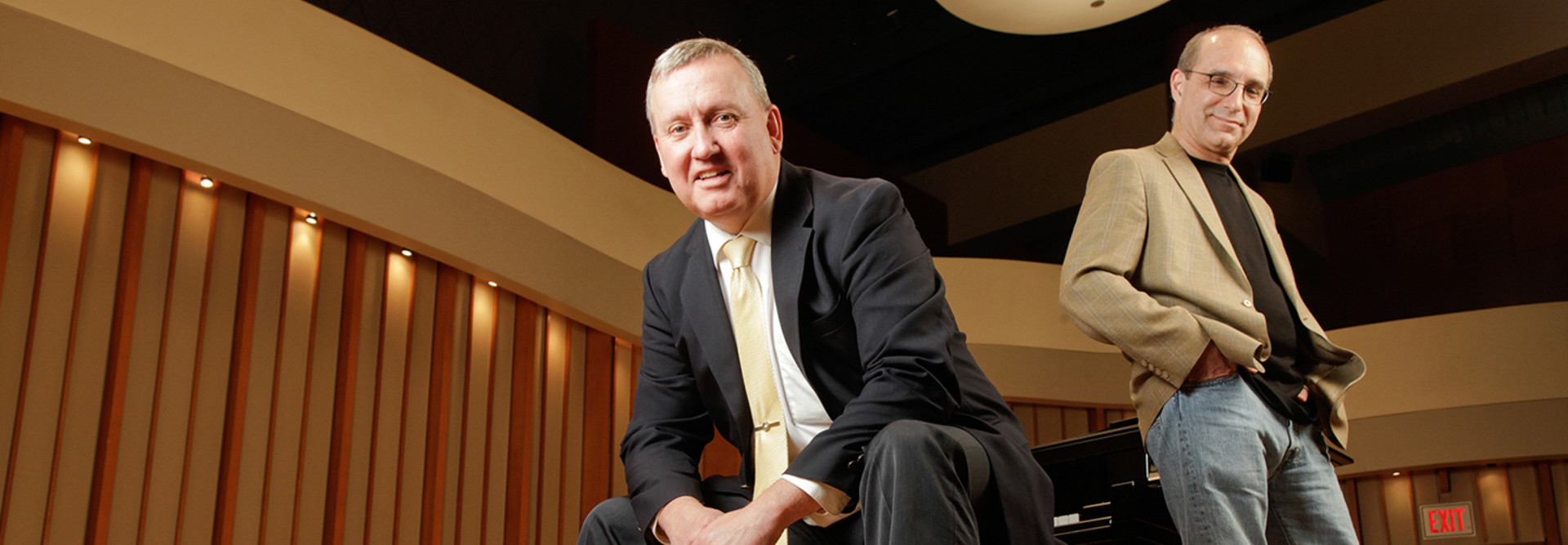Conservatory Tech Makes Sweet Music
Colburn School IT Director Oyvind Dossland shares concerns similar to his colleagues at other colleges and universities — meeting the growing demand for wireless services, confronting BYOD challenges, maintaining websites, and integrating PC-based administrative tasks with instructional technologies.
"We try to make people happy," Dossland says. "But our customers are a little different."
The students and faculty of the Los Angeles–based performing arts school make some unique demands on the IT department, from overcoming lag time so that online music lessons can be provided, to maintaining a scalable, redundant file storage system for audio and video recordings, and supporting all of the spaces where music technology is taught.
Teaching Technology
The classroom in which Colburn's mandatory Introduction to Music Technology course takes place includes nine workstations, each with a desktop computer and a variety of audio recording and editing software, a USB-connected professional keyboard, and a Pro Tools Mbox digital interface.
James Walker, a professor of flute and chamber music, teaches the course and designed the classroom, which is supplemented by an additional four workstations in the Colburn School's library. Like many tech-savvy instructors, Walker recognizes that, ultimately, the device is not as important as how it's used.
"I'm hoping that more and more students will use technology wisely. The bottom line isn't technology; it's how much do you practice, and your practice has to be efficient and brilliant," he says.
Frequently, even the most well-funded conservatories can't offer regular live accompaniment, but software such as SmartMusic can provide responsive accompaniment to fill the gap and help students to become "better musicians, faster," Walker says.
Apps and Opportunities
Technology is making inroads — albeit slowly — at many of the country's most respected conservatories, those bastions of musical and cultural tradition rooted in 19th-century pedagogy.
At the Peabody Institute of The Johns Hopkins University in Baltimore, faculty members Ken Johansen and Travis Hardaway have developed an app, called Read Ahead, to help students improve sight-reading.
Sight-reading is tough to teach, Johansen admits: "It's usually one-on-one or done in small groups, and it's something that some teachers aren't really sure how to teach."
Percentage of institutions that offer either a required or an elective course in music technology
SOURCE:"Defining Undergraduate Music Technology Competencies and Strategies for Learning" (Peter Webster and David Williams, 2012)
While the art can be broken down into a series of smaller skills, "the most difficult thing is reading ahead," he says. "In the past, teachers have taken a business card and held it over a score manually, to try to encourage their students' eyes to go forward."
Hardaway says he saw an opportunity to change that, and proposed he and Johansen work together to develop an app that makes the score disappear as a student plays. The work earned them a $100,000 grant from TEDCO — an agency that facilitates the transfer and commercialization of technology out of Maryland universities and federal research labs — along with the enthusiasm of early testers.
In Boston, the Berklee College of Music has embraced technology, says Jeanine Cowen, the college's vice president for curriculum and program innovation. Its effects are being felt most keenly in the utility of blended learning.
"In the past, you would teach [critical listening] in a studio because you wanted to be in a great listening environment," Cowen says. "The student would get to hear something once, maybe twice in class. But now that we've moved those assets online, they can listen to it over and over and over again."
In keyboard skills, meanwhile, students can review video demos rather than strain to see alongside a dozen of their peers during live instruction sessions.
"The time spent online is far surpassing our expectations of what students are getting back from it," she says.
In fact, Berklee recently expanded its facilities in Boston's Back Bay, opening an 18-story multipurpose building in February. The 14,000 square feet of dedicated technology space includes three recording studios, a dubbing stage and four production suites, among other facilities.
"We're not intending to grow our overall student enrollment," Cowen hastens to add. "Rather, it's an indication of the fact that music technology is so important. Even keeping our student population the same, we just needed more music technology space."
Students today can choose training in practical audio mixing and editing technologies, for instance — highly sought-after skills in film and television production.
Percentage of respondents who suggest students should learn music technology on their own outside of class
SOURCE: "Defining Undergraduate Music Technology Competencies and Strategies for Learning" (Peter Webster and David Williams, 2012)
Colburn's Walker says some software tools also are helping his students to become better creators, not just performers: "I'm pushing the kids to create their own compositions. Most are super high-end classical players, who aren't involved a lot in the creative process.
"Most of them get a real kick out of triggering that side of their brain."
Balancing Old and New
"If you take a doctor from 50 years ago and set him in a doctor's office currently, he or she would be pretty lost," says David Brian Williams, immediate past president of the College Music Society and a member of the National Association for Music Education (NAfME). "If you take music teachers from 50 years ago and dropped them in present-day classrooms, they'd be comfortable with the same piano and, instead of a chalkboard and record player, maybe a white board and CD or MP3 player." For a man with more than 40 years of involvement in music and technology, the analogy illustrates an often-frustrating rate of change in education and the need for more integrated training in music technology in the undergraduate music curriculum.
Through three surveys to tertiary music programs across the nation, Williams and Peter Webster, vice dean of the division of scholarly and professional studies, University of Southern California Thornton School of Music, propose a set of eight basic competencies in music technology that their data show all music undergraduates should master by graduation. Their NAfME colleague, Tom Dean, has worked on a similar set of standards for K–12 education. Dean says student teachers from some university music programs join his high school classes only to find that his students are receiving a better music technology education than student teachers at the collegiate level. There is great potential for reaching nontraditional music students through current software products.
"My students go from not being creators in the beginning to being creators," Dean says. "Today I had to kick about 15 kids out of my lab and tell them 'You have to go home now,' because they've been hanging around after school, creating."
But he sometimes worries that those students won't fit into undergraduate music programs because, despite their skills in music technology and audio engineering, there's often no place for a student who doesn't also work with a traditional instrument.
Still, there's reason to be selective when incorporating technology into music education. Robert Duke, the Marlene and Morton Meyerson Centennial Professor at University of Texas at Austin and director of the psychology of learning at the Colburn School, worries about the potential for distraction.
"The idea of having technology in music is nothing new," he says, noting that every instrument constitutes a piece of technology. "Ultimately, all of us are trying to teach students to become better listeners. To the extent that technological tools are applied to accomplishing that goal, I think that's a wonderful thing," Duke says, "but the tools won't make that happen."
Ultimately, music education is about making music. "The technology is like understanding a language. You want to get to a point where you're not thinking about the words or what you're trying to say, but you're just thinking about the concepts you're trying to convey," Berklee's Cowen says. "We hope that the technology falls away as an impediment and just becomes second nature."









